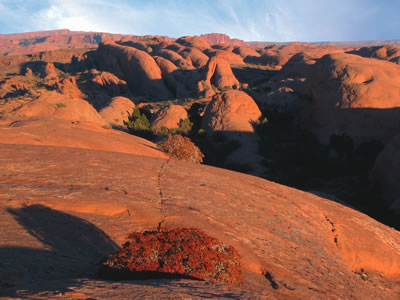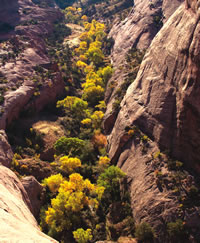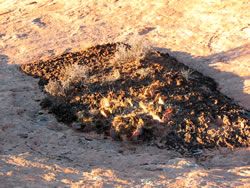Hiking
Happenings November 2005
The Great
Sand Sea
by Rory Tyler
180 million years ago,
before the Atlantic Ocean came to be, dinosaurs trekked
from oasis to oasis across near-infinities of windblown
dunes in the great western sand sea of the super-continent,
Pangea. The remains of this massive desert is now known
as Navajo Sandstone - one of the impressive landforms that
sets southern Utah apart from anywhere else in the world.
There is much more to say about the Navajo than I can begin
to tell here. It is dangerous and forgiving. Beautiful
and frightening. Inspiring and enigmatic. It will take
all you’ve got - body, mind, and soul – then
that much again.

Navajo Sandstone Fins
at Sand Flats |
That is what Moab’s
prolific and preeminent outdoor-guide authors, Fran and
Terby Barnes, gave to the Navajo Sandstone. If you’re
interested in a deeper understanding of this fascinating
geology, find a copy of Fran’s “Slickrock Hikes” and
a Summer 2005 edition of Canyon Legacy, the publication
of the Dan O’Laurie Museum of Moab. It’s about
Navajo Sandstone and is rightly and honorably dedicated
to Fran in memorium.
There’s no other feeling like walking on top of a long Navajo rock
fin. The footing is terrific. Intricate sandstone patterns, lichen gardens,
pinyon-juniper bonsais, improbable water holes teeming with life, and
miniature crypto-forests ripple by underfoot while you soar above an
impossibly tilted, tinted, delicate world. Yeah…delicate. If you
plod across a crypto bed, for example (see inset), it could take a century
to heal. If you break a thin stone into three pieces (the classic man-track),
or step on a wind-sculpted rock flake, it will never repair itself and
you will have left the landscape’s perfection diminished by that
much.
When traveling through the Navajo Sandstone you have to learn the dance;
weaving between and vaulting across crypto-filled cracks; tight-roping
heel-to-toe from one tiny wash bottom to the next; prancing cross-footed
from stone to stick to slickrock and back again; dancing your part as
if the desert were a ballet choreographed by Mother Nature herself. It
takes a commitment and concentration that probably doesn’t exist
in any other terrestrial ecosystem.
The Slickrock Trail, which is on all the maps, is a good place to get
acquainted with this ancient/modern desert. Navajo Sandstone is ‘slickrock’ in
name only. True, when the cowboys, et.al., came through with their iron-rimmed
wheels and steel-shod horses they found it a bit slippery. But for Vibram
soles, rubber tires, and crack-jamming rock climbers it’s the next
best thing to being Spider Man. And don’t let the Slickrock Trail’s
reputation as a mountain-biking mecca put you off. There’s plenty
of room and scenery for everyone.
 For
your next trick, backtrack a bit. Park by the entry booth to the Sand
Flats recreation area and walk up the road to the power lines. Where
the road turns left, you turn right, walk over to the edge, and either
go through that little canyon or clamber onto the nose of the rock
fin on the other side of the crack (the preferred way). This walk starts
out easily, but becomes increasingly more complex and challenging as
you head south. Either route takes you onto a set of slickrock ridges
that lead to the abyss of Mill Creek Canyon. For
your next trick, backtrack a bit. Park by the entry booth to the Sand
Flats recreation area and walk up the road to the power lines. Where
the road turns left, you turn right, walk over to the edge, and either
go through that little canyon or clamber onto the nose of the rock
fin on the other side of the crack (the preferred way). This walk starts
out easily, but becomes increasingly more complex and challenging as
you head south. Either route takes you onto a set of slickrock ridges
that lead to the abyss of Mill Creek Canyon.
If you get as far as Pocket Arch, just above the Mill Creek pour-off,
the landscape is as giddy as it gets…and dangerous. A young mountain
lion fell from here a few years ago and I’ll bet he was a little
more agile than you or I. Another note of caution: If you head out this
way, pay careful attention to your back trail. You really don’t
want to take an untried route home unless you’ve got a lot of extra
time and energy to gamble with.
Did I mention dinosaurs? During the early Jurassic, the great Pangean
sand sea held oases that were home to a variety of dinosaurs. These oases
left thin deposits of gray limestone along the southern edge of the desert,
including the Moab region. For a good look at some dinosaur tracks go
to the Poison Spider parking lot on Potash Road. The gray boulders on
the hillside, about 100 yards upstream from the privy, have several excellent
track-ways. (The white coating on a few of them is from a latex mold
some stupid jerk made a few years ago.) If you scramble up the hill just
a little higher there are more prints on the vertical boulders next to
the cliff, along with some interesting Indian petroglyphs over to the
right. Once you learn to recognize the cross-beds and free boulders of
Navajo limestone, you can keep an eye out for dino sign anytime.

Cryptobiotic soil
garden
|
Rory Tyler is available for cowboy
poetry/campfire song gatherings which include lore, science,
history and lies of the Moab area. (Suitable for all
age groups). Rates are negotiable. Give Rory a call at
435-260-8496.
|

 For
your next trick, backtrack a bit. Park by the entry booth to the Sand
Flats recreation area and walk up the road to the power lines. Where
the road turns left, you turn right, walk over to the edge, and either
go through that little canyon or clamber onto the nose of the rock
fin on the other side of the crack (the preferred way). This walk starts
out easily, but becomes increasingly more complex and challenging as
you head south. Either route takes you onto a set of slickrock ridges
that lead to the abyss of Mill Creek Canyon.
For
your next trick, backtrack a bit. Park by the entry booth to the Sand
Flats recreation area and walk up the road to the power lines. Where
the road turns left, you turn right, walk over to the edge, and either
go through that little canyon or clamber onto the nose of the rock
fin on the other side of the crack (the preferred way). This walk starts
out easily, but becomes increasingly more complex and challenging as
you head south. Either route takes you onto a set of slickrock ridges
that lead to the abyss of Mill Creek Canyon. 